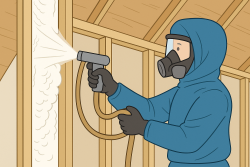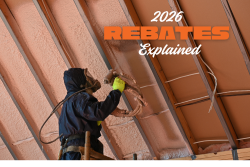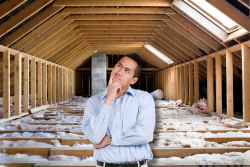Although you can never completely stop heat from escaping your house, homes with quality insulation are significantly more efficient. If you are considering upgrading your home’s insulation, find out what the benefits are, what constitutes high-quality insulation, and signs your house is suffering major heat loss.
SIGNS OF HEAT LOSS
If you think your home is well-insulated because the attic’s insulation is sufficient—think again. Heat doesn’t just travel up, it moves in all directions. Attic insulation accounts for convection heat, which travels upward, but don’t be mistaken . . . you lose heat through your walls, windows, doors, and floors.
Check your home's susceptible areas for heat loss to ensure it is properly insulated. You might find that your walls completely lack insulation and that your window frames allow a draft. Walls, windows, doors, and floors are the majority of your house. If you are only insulating your attic, you lose heat through most of the square footage of your house.
If your home is suffering heat loss, you are probably already aware of it—which is why you are reading this blog. However, if you are unsure or if you want to improve your insulation, conduct an inspection and ask yourself these questions:
- Do I feel a draft in any areas of my home?
- Are rooms near doors and windows a dramatically lower temperature than other areas of my house?
- Do I find I’m constantly turning the temperature up or adjusting the thermostat?
- Do I live in an older home?
- Are most of the cold areas in my house near the perimeter?
Did you answer yes to any of these? Schedule an inspection for your insulation and heat ducts. You should conduct regular home inspections anyway; just make sure you ask about the quality of your home’s insulation while you’re at it.
Your home is able to pass inspection without having great insulation, so you may never see a need to upgrade. But the benefits of having good insulation are huge.
BENEFITS OF HAVING HIGH-QUALITY INSULATION
Obviously, the main benefit of living in a well-insulated house is that you feel more comfortable and warm, right? Well, yes, but look at all of these other benefits it provides:
- Provides Better Acoustics
- Provides Outdoor Noise Cancellation
- Saves Energy—Lowering Your Carbon Footprint
- Improves Moister Control
- Protects Against Pests
- Saves Money
It doesn’t cost very much to upgrade your insulation; it is definitely less than upgrading your windows—but you will save a bundle by making your home energy-efficient. You not only save to heat it, but to keep it cool. There is no way to calculate the exact amount of money good insulation will save you, but here is an example to show the difference quality insulation makes.
An average-size home in a temperate climate will save $760 a year in heating and cooling expenses and pay for the cost of installing improved insulation in 3 years or less. In addition, it saves about 1040 kg of carbon dioxide from polluting the atmosphere.
This assumes the house uses gas and electricity for temperature control and that the home is in a temperate climate. You can imagine the difference of upgrading a home in an area with more dramatic temperatures or a home that needs major renovations.
WHAT CONSTITUTES AS HIGH-QUALITY INSULATION
Okay, you are convinced that improving insulation is worth the investment. But how do you know what high-quality insulation looks like? After all, there are a lot of different ways to insulate a house. What is the best way?
HIGH-QUALITY INSULATION OPTIONS
The best solution for you will depend on your home and the areas you are suffering heat loss. Here are two great ways to insulate:
- Spray Foam Insulation—is a two-part mixture of isocyanate and polyol resin. This insulation offers an alternative to traditional fibreglass insulation. It is applied to an area as a liquid spray, where it expands and hardens, filling every crevice. Spray foam is high-quality insulation because it makes your home virtually seamless.
- Blown-in Insulation—uses cellulose or from plant fibre, like paper, which has low thermal conductivity. Cellulose is chemically treated with borates which are fire-retardant and offers safety in addition to reducing heat loss. Blown-in insulation offers homes high-quality insulation, improved moisture control, and is green.
If you are considering upgrading your insulation, it is suggested you consult with a company that specializes in installing it. Professionals are better equipped to spot potential problem areas, maybe some you overlooked. And rather than trying to figure out solutions on your own, a professional will provide you with direct, cost-effective solutions.
There really is no reason to suffer through another cold winter shelling cash out for heat. Once you find ways to eliminate heat loss in your home, you will start sleeping warm and cozy at night—while saving money.


















